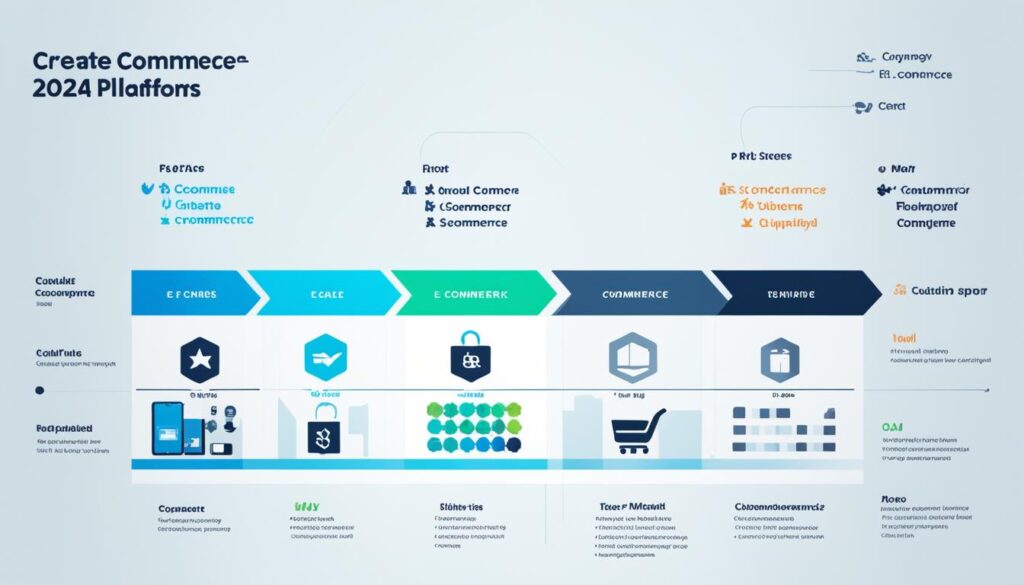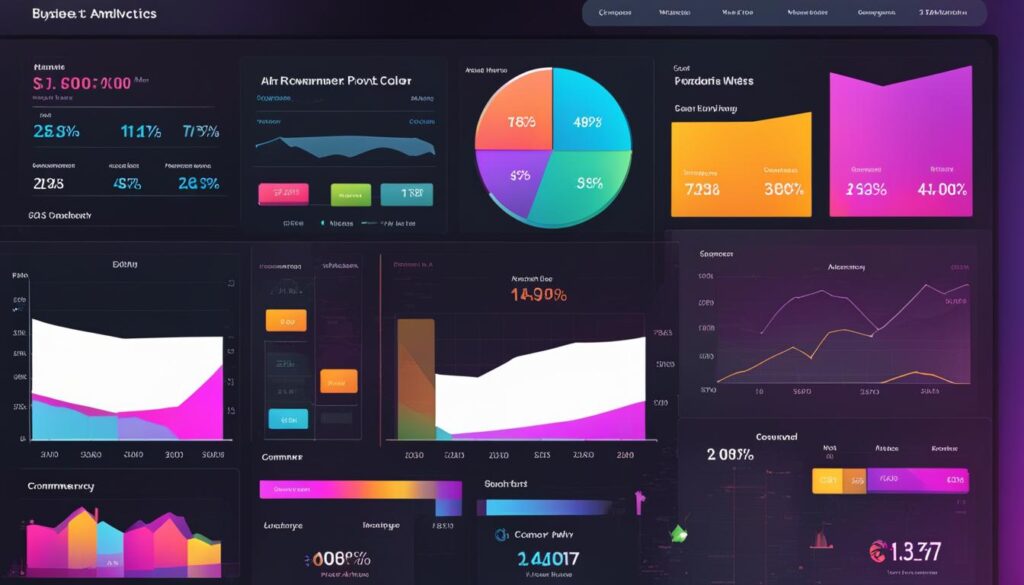In a world where digital shopping carts are increasingly replacing traditional checkout lines, an astonishing revelation surfaces: global e-commerce sales catapulted to nearly a staggering $5.7 trillion in 2022 alone.
Key Takeaways
- Understanding the potential of e-commerce is critical, with billions in sales signifying a booming industry.
- Discover how to start an online store by tapping into less explored markets within the digital space.
- The journey to launch an e-commerce store involves meticulous planning, from sourcing to storefront design.
- Creating a robust business plan is crucial to methodically create an online store that stands the test of time.
- Mastering digital marketing and SEO are essential tactics for driving significant traffic and sales to your e-commerce store.
- Choose the best e-commerce platform that aligns with your business goals to ensure a smooth launch and operating experience.

If you’ve dreamed of staking your claim in this digital gold rush, now is the time to learn how to create an e-commerce store and establish your brand online.
As the virtual shelves continue to expand, a mere fraction, less than 14%, of retail sales have been realized through e-commerce, hinting at a vast, largely untapped marketplace ripe for the taking.
Embarking on your quest to launch an e-commerce store begins with a well-charted map through the online retail terrain.
Whether you are looking to start an online store as a fresh entrepreneurial venture or as an addition to a brick-and-mortar establishment, this ultimate guide for 2024 serves as the compass to your success.
From the drawing board of product selection to the grand e-commerce website launch, equip yourself with the tools and strategies vital for flourishing in the ever-evolving ecosystem of internet commerce.
Understanding E-Commerce: Basics to Advanced Concepts
As the digital economy continues to expand, understanding the myriad aspects of e-commerce becomes essential for those looking to dive into setting up an e-commerce business.
From the initial steps to building an online store to executing a successful online retail store launch, the journey to establish a robust e-commerce enterprise involves grasping foundational concepts and strategies.
What is E-Commerce?
E-commerce, short for electronic commerce, is a sweeping term that covers the buying and selling of goods and services over the Internet.
This modern marketplace has revolutionized the way business is conducted, providing unprecedented accessibility, convenience, and reach.
Now more than ever, with a few clicks, consumers can access products and services from around the world, while businesses can operate 24/7, transcending geographical limits and traditional retail hours.
Types of E-Commerce Models: Pros and Cons
Within the vast expanse of e-commerce, various models present unique opportunities, each with its own set of advantages and considerations.
| E-Commerce Model | Pros | Cons |
|---|---|---|
| B2C (Business-to-Consumer) | Direct interaction with end-users, potential for rapid growth, and personalized marketing strategies. | High competition, customer service challenges, and the necessity for constant engagement. |
| B2B (Business-to-Business) | Larger order volumes, recurring purchases, and potential for establishing long-term client relationships. | Longer sales cycles, complex decision-making processes, and typically higher customer expectation levels. |
| C2C (Consumer-to-Consumer) | Encourages peer-to-peer sales, diverse marketplaces, and can foster communities. | Dependency on platform policies, potential for fraud, and less brand control. |
| C2B (Consumer-to-Business) | Consumers can offer products/services to businesses, innovative market contributions, and pricing leverage. | Niche market approach, higher individual competition, and often inconsistent demand. |
| Dropshipping | Low upfront investment, no need for inventory management, and a wide range of products to sell. | Lower profit margins, less control over shipping and handling, and reliance on third-party suppliers. |
By familiarizing themselves with these models and evaluating their pros and cons, aspiring entrepreneurs can better navigate the course of e-commerce store setup and align their decisions with personal goals and market needs.
With a firm understanding of these foundational concepts, the following steps will edge you closer to a triumphant online retail store launch.
Planning Your E-Commerce Venture
Embarking on an e-commerce venture requires a methodical approach to ensure long-term success. Begin by carving out a niche that stands out in the digital market landscape.
Once you’ve honed in on your niche, delve into meticulous market research for e-commerce. This process lays the foundation for your business and is a critical step you shouldn’t overlook.
Identifying Your Niche and Target Market
Finding a unique niche helps cater to a specific audience and reduces competition. Consider the needs and preferences of your target market.
Ask yourself, what gaps exist in the current market that your e-commerce business can fill?
This understanding will be instrumental in developing a business model that precisely aligns with customer demands.
Conducting Market and Competitor Research
Thorough competitive analysis in e-commerce is not just about identifying your competition. It’s about understanding their strategies, strengths, and weaknesses.
Analyze their online presence, customer reviews, pricing, and product range. Leverage tools and techniques like SWOT analysis to dissect both your potential rivals and your own business to create strategies that offer a competitive edge.
Crafting a Comprehensive Business Plan
An effective e-commerce business plan is your roadmap to success. It should detail every facet of your business, from the operational framework to financial projections.
A comprehensive plan not only guides your strategies but also attracts investors by showcasing the thoroughness of your preparation and the viability of your venture.

Incorporate the findings from your research to structure a business plan that speaks to your identified niche, outlines clear objectives, and describes the tactics you will employ to capture and grow your segment of the e-commerce market.
Remember that this e-commerce business planning stage is ongoing. You must remain flexible to adapt to market changes and customer feedback, ensuring the longevity and prosperity of your e-commerce store.
Establishing Your Online Presence
Embarking on the journey to create an e-commerce website can be an exciting venture but requires meticulous planning.
Your online success begins with deciding on the best e-commerce platform that aligns with your business goals and customer needs. Further, you’ll want to choose a domain that represents your brand and speaks to your audience.
The amalgamation of user experience design and search engine optimization for e-commerce will ensure that your digital presence is strong and consistent.
Selecting the Right E-Commerce Platform
With numerous e-commerce solutions available, selecting one can be daunting. You must carefully assess features, scalability, support, and pricing before taking your pick.
Industry leaders like Shopify and Magento often come to mind thanks to their robust functionality and user-friendly interfaces.
Factors like transaction fees, product management capabilities, and theme variety play a pivotal part in your platform decision.
Domain Registration and Website Building
Your domain name is your brand’s online address—the starting point of your virtual storefront. Ensure it’s concise, memorable, and embodies your business essence.
Upon securing your domain, the focus shifts to website development. User navigation should be intuitive, with fast load times and responsive design ensuring your site is accessible on all devices.
Designing Your E-Commerce Store for Optimal UX
Achieving a powerful user experience is essential. Not only does your online store need to be visually appealing, but it also needs to foster seamless interaction to convert visitors into loyal customers.
Intuitive search functions, detailed product descriptions, and simple checkout processes all contribute to a site that customers will want to return to.
SEO Strategies for E-Commerce Success
Comprehending the facets of SEO is imperative to drive organic traffic to your new e-commerce outlet.
Effective strategies encompass keyword research tailored to your products, optimized meta descriptions, and quality content marketing that resonates with your audience.
Regularly monitoring your site’s performance and making adjustments based on analytics is the key to staying ahead in search rankings.
| E-Commerce Platform | User-Friendly | Customization | Support | SEO Features |
|---|---|---|---|---|
| Shopify | High | Medium | 24/7 | Integrated SEO Tools |
| Magento | Advanced | High | Community Forums | Robust SEO Support |
| WooCommerce | Depends on WordPress Theme | High | Community Support | Plugins Available |
As you can see, each platform has its strengths catered toward different business needs and it’s vital to choose one that not only meets your current requirements but also supports the growth of your e-commerce empire.
Remember, a strong online presence is more than just a beautiful website, it’s about creating a seamless, search-engine-optimized experience that will captivate and retain customers.
As you work through these key steps, keep your users’ desires and expectations at the forefront to ensure your e-commerce venture flourishes in the digital marketplace.

Product Selection and Supply Chain Management
Navigating the world of e-commerce can be challenging, especially when it comes to the backbone of your business: the products you sell and how you get them to your customers.
Excellence in product selection and supply chain management sets the foundation for a thriving online store.
Mastering the art of sourcing products for e-commerce, setting up an e-commerce catalog, and devising a killer e-commerce pricing strategy are key steps toward building a successful e-commerce brand.
Sourcing Products: Wholesale, Dropshipping, and Manufacturing
Starting with product selection, you must consider various sourcing methodologies. Wholesale buying offers economies of scale, while drop shipping allows for a low-risk inventory.
If you’re looking for uniqueness, turning to manufacturing for bespoke products may serve you well.
Each method has its benefits and choosing the right one depends on your business model, capital, and market niche.

As you consider these options, reflect on the long-term sustainability of your supply chain. Strong relationships with suppliers are essential and leveraging technology to track and manage inventory can lead to greater efficiency and customer satisfaction.
Setting Up Your Product Catalog
When setting up your e-commerce catalog, organization is paramount. Your product listings should be clear, concise, and complete with high-quality images and engaging descriptions.
A rich catalog begets customer trust and improves conversion rates. Ensure that your catalog design is intuitive, allowing customers to easily find and browse through products, thus fostering a streamlined shopping experience.
Pricing Strategies for E-Commerce
Finally, let’s discuss the e-commerce pricing strategy. Your strategy should be robust, factoring in costs, market demand, competitor pricing, and perceived value.
Options include ‘cost-plus pricing‘, where you add a markup to the cost of goods, and ‘value-based pricing‘, which is determined by how much customers believe a product is worth.
Aim to craft a pricing structure that entices your target audience while maintaining your profitability.
By understanding and optimizing these crucial elements, you’ll be well on your way to developing an e-commerce business that not only meets market needs but exceeds customer expectations.
Legal and Administrative Steps
Embarking on an e-commerce venture requires not just business acumen but also a thorough understanding of the legal and administrative obligations.
Before diving into the world of online retail, you’ll need to take several key steps to ensure your business operates within the bounds of the law, safeguarding yourself from potential legal issues and fines. Let’s take a concentrated look at what this involves.

Registering Your E-Commerce Business
To officially launch your e-commerce operations, selecting a legal structure and registering your business is paramount.
Whether you opt for establishing an LLC, a corporation, or a sole proprietorship, knowing the specific regulatory requirements of your chosen entity is critical.
Obtaining an Employer Identification Number (EIN) is a necessary step for tax purposes and is often a prerequisite for opening business banking accounts or applying for licenses.
Understanding E-Commerce Taxes and Regulations
E-commerce taxation can be complicated, varying by state and the type of products sold.
You need to comprehend the nexus concept, which relates to your business’s physical presence and how it affects your tax liabilities.
Additionally, staying informed on e-commerce regulations, including privacy policies, data security, and consumer rights, will help you manage your online business within legal parameters.
| Legal Entity | Pros | Cons | Recommended For |
|---|---|---|---|
| Sole Proprietorship | Simple setup, full control | Unlimited personal liability | Small-scale sellers, low-risk products |
| LLC | Limited liability, tax benefits | More regulations, annual fees | Businesses expecting growth, seeking investment |
| Corporation | Limited liability, raising capital | Complex structure, double taxation | Large operations, aiming for external funding |
Payment Processing Solutions
As your e-commerce business thrives, the ability to carry out seamless e-commerce transactions becomes imperative to customer satisfaction.
Selecting the most efficient payment gateways for e-commerce is crucial and should be strategically approached to ensure secure and flexible payment options for customers.
Integrating payment processing solutions necessitates a keen understanding of the features offered by different providers.
Choosing and Integrating Payment Gateways
When it comes to payment gateways, you have several reputable options at your disposal. Each gateway comes with its unique set of features, cost structures, and security protocols.
Below we compare some of the leading payment gateway providers to help you make an informed decision for your e-commerce platform.
| Provider | Transaction Fees | Security Features | Payment Methods Accepted | Platform Compatibility |
|---|---|---|---|---|
| PayPal | 2.9% + $0.30 per transaction | Fraud protection, encryption | PayPal, credit/debit cards, PayPal Credit | Widely compatible |
| Stripe | 2.9% + $0.30 per transaction | Machine learning fraud detection, encryption | Credit/debit cards, Apple Pay, Google Pay | Highly customizable for various platforms |
| Square | 2.6% + $0.10 per transaction | Chargeback protection, secure tokenization | Major credit/debit cards, gift cards | Ideal for both online and physical stores |
Integrating these payment gateways into your e-commerce site ensures a secure and frictionless checkout process.
Look out for features like multi-currency support, which could be a critical factor if you operate globally.
The right choice will depend largely on your specific business needs, including transaction volume, market location, and e-commerce platform architecture.

Remember that the ease of integrating payment processing can make or break the check-out experience your customers face.
A favorable experience can significantly diminish cart abandonment rates, enhance transaction security, and improve the overall fluidity of your e-commerce operations.
With an optimal combination of reliability and user-friendliness, your chosen payment gateway will play a pivotal role in the growth and sustainability of your e-commerce business.
Shipping and Fulfillment Strategies
As you venture further into the realms of e-commerce, the lifeline to your business’s success can often be attributed to how effectively you manage shipping and order fulfillment.
A streamlined shipping strategy can be the competitive edge that sets you apart from others in the digital marketplace.
It’s essential to understand the intricacies of e-commerce shipping solutions and order fulfillment in e-commerce to ensure customer satisfaction and repeat business.

Setting Up Shipping Options and Logistics
When it comes to e-commerce shipping solutions, presenting a range of shipping options can cater to the diverse preferences of your customers.
The cost, speed, and reliability of these options play a pivotal role in your customers’ purchasing decisions. It’s not only about selecting carriers; it’s about cultivating a logistical system that supports the rapid movement of goods from checkout to delivery.
- Access multiple carriers to offer competitive rates and delivery times.
- Implement real-time tracking systems to maintain transparency with customers.
- Offer free shipping thresholds to encourage larger purchases.
- Consider flat-rate shipping for simplicity and consistency.
Managing Returns and Exchanges
Effectively handling returns and exchanges is synonymous with building a trustworthy brand. Your policies around this can either enhance or tarnish your reputation.
Thus, it’s important to design a returns system that promotes a hassle-free experience for customers while minimizing costs and logistics challenges for your business.
Your return policy should be a reassurance, not a deterrent. Make the process clear and accessible, and you’ll inevitably foster customer loyalty.
- Clarify the terms of returns and exchanges on your website.
- Set a reasonable time frame for accepting returns to maintain fairness.
- Include pre-printed return labels to simplify the process for customers.
- Analyze return trends to improve product quality and customer satisfaction.
Your strategic approach to shipping and fulfillment directly influences customer retention and brand advocacy.
As the e-commerce landscape evolves, so should your tactics in refining shipping efficiencies and accommodating customer needs post-purchase.
Remember, the ultimate goal is a holistic shopping experience from first click to final delivery, and beyond.
Launching Your Store
The moment has arrived to propel your digital storefront into the spotlight and commence your journey in the expansive e-commerce landscape.
A successful launch is pivotal for establishing your brand’s presence and setting the tone for future growth. With meticulous planning and an adept online store pre-launch strategy, you’re paving the way for a prosperous e-commerce venture.
Now, let’s delve into the essential last-minute checks and marketing strategies to elevate your e-commerce store launch.
Pre-Launch Checklist
Prior to unveiling your e-commerce platform to the public, it’s crucial to scrutinize every detail to ensure a seamless shopping experience for your customers.
This checklist serves as your roadmap to opening your doors with confidence:
- Final testing of website navigation and user experience (UX)
- Brisk performance checks for quick loading times
- Secure payment process validation across all transaction types
- Inventory accuracy review and stock level verification
- Implementation of robust customer support channels
Marketing Your E-Commerce Store at Launch
The initial buzz generated during your e-commerce marketing at launch can spearhead user engagement and spark the interest of potential customers.
Leveraging a mix of promotions and digital strategies ensures your brand makes a memorable grand entrance:
- Deploying targeted social media campaigns to generate anticipation
- Executing email blasts to announce your opening, complete with exclusive offers
- Introducing early access or special deals for first-time buyers
- Engaging with influencers to tap into wider audiences
Capitalize on every opportunity to create a strong narrative around your store’s unique value propositions and invite shoppers to be a part of your brand’s inaugural journey.

Remember, the fusion of thorough preparation and innovative marketing techniques is the cornerstone of a prominent e-commerce store launch.
While this is just the beginning, a focused launch strategy places you on the path toward achieving your business aspirations in the competitive online marketplace.
Marketing and Customer Acquisition
Once your e-commerce store is up and running, it’s essential to focus on strategies that will help you attract and retain customers.
Effective e-commerce digital marketing is multidimensional, encompassing various tactics that when combined, create a comprehensive approach to customer acquisition and brand building.
Digital Marketing Strategies for E-Commerce
Successful e-commerce digital marketing goes beyond a single campaign or platform, it’s a continuous process that adapts to trends and customer behaviors.
These strategies should guide your customers through the buying funnel, converting their interest into sales.
Utilizing tools like SEO, content marketing, and paid ads can amplify your reach and place your products in front of the right audience.
Leveraging Social Media and Email Marketing
With a solid social media strategy for e-commerce, you can engage users where they spend a significant amount of time. Each platform offers different advantages – Instagram excels in visual storytelling, while Twitter is great for quick, conversational engagement.
Email marketing, on the other hand, is a powerful tool for personalized communication, allowing you to share targeted promotions, new arrivals, and valuable content to nurture your customer base.

SEO Optimization Post-Launch
Never underestimate the power of high-ranking product pages. SEO optimization is an ongoing process that helps maintain the visibility of your e-commerce store.
Post-launch, it’s vital to monitor and update your SEO strategy to keep up with the algorithm changes of search engines and the evolving nature of consumer search behaviors.
| Strategy | Benefits | Tools & Platforms |
|---|---|---|
| Social Media | Engages with customers, builds community, enhances brand visibility | Instagram, Facebook, Twitter, Pinterest |
| Email Marketing | Direct personalized communication, high ROI, customer retention | Mailchimp, SendGrid, Constant Contact |
| SEO | Increased organic traffic, higher search rankings, improved user experience | Google Analytics, Moz, SEMrush |
| Content Marketing | Educates customers, builds brand authority, drives inbound traffic | Blog posts, E-books, Infographics |
| Pay-Per-Click Advertising | Immediate traffic, targeted advertising, measurable results | Google Ads, Bing Ads, Facebook Ads |
Maintaining and Growing Your E-Commerce Business
As the digital marketplace continues to evolve, maintaining and scaling your online store is crucial for long-term success.
Monitoring the right performance metrics through e-commerce analytics will offer valuable insights that inform strategic decisions.
Consistent and proactive customer service for e-commerce ensures that consumer trust in your brand strengthens over time. To be ahead of the competition, scaling an online store is about expanding wisely while keeping the core values of your business intact.
Utilizing Analytics for Business Insights
Delving into e-commerce analytics can reveal patterns and trends that are crucial to enhancing your business strategy.
By understanding customer behaviors and preferences, you can tailor your marketing efforts to increase engagement and conversion rates.
Key performance indicators (KPIs), such as customer acquisition cost, lifetime value, and conversion rates, provide a clear picture of where your business stands and highlight areas for improvement.
Customer Service Excellence
Exceptional customer service is the foundation of any thriving e-commerce business. It extends beyond solving problems, it’s about creating a seamless, positive experience every time customers interact with your brand.
This includes a responsive support system, easy-to-navigate help resources, and a hassle-free return policy. The goal is to make shopping with your online store a pleasant and memorable experience that customers are eager to repeat and share.
Scaling Your E-Commerce Business
When it comes to scaling an online store, the focus should be on sustainable growth strategies. This could mean expanding your product line, exploring new markets, or investing in marketing channels that have proven successful.
Growth also demands a reassessment of your logistics, from inventory management to delivery systems, ensuring that your business can handle an increase in volume without compromising service quality.

Key Strategies for Scaling:
| Strategy | Benefits | Considerations |
|---|---|---|
| Market Expansion | Reaches new customers and demographics | Understanding cultural distinctions and preferences |
| Product Diversification | Attracts different consumer segments | Aligning new offerings with brand identity |
| Enhanced Marketing | Improves brand visibility and engagement | Identifying the most effective channels |
| Technology Investment | Streamlines operations and customer experience | Choosing solutions that scale with your business |
| Partnership Development | Opens doors to new opportunities and expertise | Choosing partners with aligned business values |
Remember, a balanced approach is key to scaling success, one that nurtures existing customer relationships while exploring new horizons.
Embrace innovation, but let steadfast commitment to quality and service be the anchor that keeps your e-commerce venture grounded as it soars to new heights.
E-Commerce FAQs
Embarking on an e-commerce venture raises several questions regarding initial investments, the suitability of the business model, and the challenges one might face.
Understanding these elements is crucial when deciding to take the leap into the digital marketplace. Here, we address some frequently asked questions to aid you in your e-commerce planning and strategy.
How Much Does It Cost to Start an E-Commerce Business?
When it comes to the cost of launching an e-commerce store, your budget might vary depending on the business model you select.
Starting with a lean approach like dropshipping could mean minimal upfront investment – often a few hundred dollars for website setup and marketing.
On the other hand, if you’re aiming for a full-fledged store dealing with inventory and custom-developed features, your expenses could reach into the thousands.
Critical costs include platform selection, inventory procurement, web development, and initial marketing outlays. Consider these variables when budgeting for your new online enterprise.
Is E-Commerce Right for You?
Taking the leap into starting an e-commerce business is a significant decision that hinges on various factors. It requires examining your enthusiasm, skillset, and the time you can dedicate. E-commerce is a potent revenue generator in a burgeoning market but is also marked by fierce competition.
Your commitment to learning and adapting to e-commerce trends and consumer behavior is vital for staying relevant and successful in the ever-evolving digital landscape.
Common Challenges and Solutions in E-Commerce
No doubt, e-commerce store challenges are abundant, from driving sufficient traffic to ensuring customer satisfaction. However, these obstacles aren’t insurmountable with strategic planning.
Employ robust marketing tactics, focus on SEO to enhance visibility, and harness the power of social media to create buzz and build trust.
Customer service can be your differentiator: Address issues swiftly and efficiently to cultivate loyal customers.
Remember, technology is your ally to streamline operations and enable scalability for your burgeoning e-commerce venture.
FAQ
How do you launch an e-commerce store?
To launch an e-commerce store, you need to identify your niche, choose your products, select the right e-commerce platform like Shopify, Magento, or WooCommerce, set up your website, create a product catalogue, organize your supply chain, and decide on pricing strategies. You also need to register your business, understand e-commerce taxes and regulations, integrate payment processing, establish shipping and fulfillment methods, create a marketing plan, and finally, launch your store with appropriate customer support.
What is the best platform to create an online store?
The best platform to create an online store depends on your specific needs and technical capabilities. Popular platforms include Shopify which is known for its ease of use, WooCommerce for its flexibility with WordPress, and Magento for its scalability and customization options. It’s essential to compare these platforms based on your business’s size, budget, and desired features.
Which steps are involved in building an e-commerce website?
Building an e-commerce website involves selecting a domain name, choosing an e-commerce platform, designing the layout, creating product pages, setting up categories, integrating payment gateways, and ensuring security features are in place. It may also include establishing SEO strategies and creating content that drives traffic to your site.
What are some effective marketing strategies at an e-commerce store launch?
Effective marketing strategies at an e-commerce store launch involve creating anticipation through social media teasers, email marketing campaigns to your subscriber list, search engine optimization, influencer collaborations, and offering special launch promotions to early customers. It’s vital to engage with your audience and build a community around your brand.
How can you optimize your e-commerce website for search engines?
You can optimize your e-commerce website for search engines by conducting thorough keyword research to guide content creation, optimizing your product descriptions and meta tags, ensuring your website has a mobile-friendly responsive design, improving site loading times, and acquiring quality backlinks. Regularly updated content and a well-maintained blog also contribute to better SEO results.
How do you manage shipping and fulfillment for an online store?
Managing shipping and fulfillment for an online store requires you to decide whether to handle fulfillment in-house or outsource to a third-party logistics provider. You need to determine shipping costs, choose reliable shipping carriers, set delivery timelines, create clear shipping policies for customers, and streamline your order processing to ensure timely dispatch.
How do you determine the right pricing strategies for an e-commerce business?
To determine the right pricing strategy for your e-commerce business, consider factors such as production costs, competitor pricing, perceived customer value, and market demand. Common pricing methods include cost-plus pricing, value-based pricing, and dynamic pricing. Also, consider psychological pricing strategies to appeal to customers’ emotions and rationalizations.
What are some challenges you may encounter when starting an online store and their solutions?
Some common challenges when starting an online store include driving traffic to the site, converting visitors into customers, managing inventory, and handling customer service and returns. Solutions include using SEO and digital marketing to attract visitors, optimizing for conversions with A/B testing, employing inventory management software, and establishing clear and efficient customer service policies.
How much does it cost to start an e-commerce business?
The cost to start an e-commerce business can vary greatly. A basic dropshipping store might be set up for a few hundred dollars, while a more complex operation with a custom-built website and significant inventory could run into the thousands. Factors influencing start-up costs include platform subscription fees, domain registration, initial stock, marketing, and legal and administrative expenses.
Is e-commerce right for you?
E-commerce may be right for you if you’re entrepreneurial, comfortable with technology, and have products or services that can be sold online. It’s also suitable if you are willing to learn about digital marketing, customer support, and the logistical aspects of running an online store. Assess your commitment level, available resources, and market potential before deciding.




